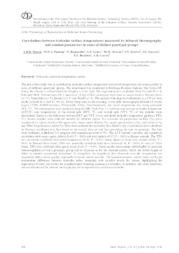Correlations between testicular surface temperatures measured by infrared thermography and seminal parameters in rams of distinct genotypic groups.
Correlations between testicular surface temperatures measured by infrared thermography and seminal parameters in rams of distinct genotypic groups.
Author(s): MOURA, A. B. B.; PANTOJA, M. H. A.; ROMANELLO, N.; LEMES, A. P.; ESTEVES, S. N.; FONSECA, J. F. da; BRANDÃO, F. Z.; GARCIA, A. R.
Summary: Abstract: The aim of this study was to correlate the testicular surface temperature with rectal temperature and semen quality in rams of different genotypic groups. The experiment was conducted at Embrapa Pecuária Sudeste, São Carlos-SP, where the climate is characterized by Köppen as Cwa type. The experiment was conducted from October/2015 to February/2016. Twenty rams (20.1 months; 67.6 kg) of four genotypes were used as semen donors: Morada Nova (n = 5), Santa Inês (n = 5), Dorper (n = 5) and Texel (n = 5). The animals were kept in confinement in a 570 m2 barn partly covered by a roof of 196 m2. Every thirty days in the morning, it was held thermography infrared of scrotal region (T300, FLIR® Systems, Wilsonville, USA). Simultaneously, the rectal temperature was being measured (RT, °C). The thermograms were analyzed using FLIR® Tools Plus 3.1 software and average testicular temperature (ATT,°C) and temperatures of the dorsal pole (DPT, °C) and ventral pole (VPT, °C) of the testicles were determined. Based on the difference between DPT and VPT, it was calculated testicular temperature gradient (TTG, °C). Semen samples were collected monthly by artificial vagina. We evaluated the progressive motility (%), gross motility (0-5), sperm count (x109 sperm/mL), major sperm defects (%), minor sperm defects (%), total defects (%) and DNA fragmentation index (%). Data were analyzed for normality by Lilliefors test. Correlations were calculated by Pearson correlation test, first based on the overall data set and then grounding the data by genotype. The data were evaluated in BioEstat 5.0 program with significance level of 5%. The ATT showed a positive and significant correlation with minor sperm defects (0.68; P < 0.05) and total defects (0.57; P < 0.05) in Dorper animals. The TTG was positively correlated with rectal temperature (0.36; P < 0.05), being higher in Santa Ines animals (0.69; P < 0.05). In Morada Nova breed, TTG was positively correlated with mass motion (0.76; P < 0.05). In rams of Texel breed, TTG was correlated with sperm count (0.65; P < 0.05). These results demonstrate individuality in testicular thermoregulation of each genotypic group and its response as for the seminal quality, which has lower degree of effect in animals considered naturalized. It strengthens the hypothesis that abnormal testicular temperature can negatively affect semen quality, especially in exotic breeds animals. The gradient increase, which stands for larger temperature difference between testicular poles, presented with positive results for semen, highlighting the importance of their use within the complementary breeding soundness evaluation. In addition, this study reinforces the contribution of the infrared thermography use in reproductive evaluation of males.. [Correlações entre temperaturas de superfície testicular mensuradas por termografia de infravermelho e parâmetros seminais de ovinos de grupos genotípicos distintos]. Resumo: O objetivo do estudo foi correlacionar a temperatura de superfície testicular com a temperatura retal e a qualidade seminal em ovinos de diferentes grupos genotípicos. O experimento foi realizado na Embrapa Pecuária Sudeste, São Carlos-SP, onde o clima predominante é caracterizado por Köppen como tipo Cwa. O experimento foi conduzido de outubro/2015 a fevereiro/2016. Vinte ovinos machos adultos (20,1 meses; 67,6 kg) foram usados como doadores de sêmen, sendo quatro genótipos: Morada Nova (n=5), Santa Inês (n=5), Dorper (n=5) e Texel (n=5). Os animais foram mantidos em confinamento, em galpão telado de 570 m2 parcialmente coberto por telhado de 196 m2. A cada trinta dias, foram realizadas pela manhã termografias por infravermelho da região escrotal (T300, FLIR® Systems, Wilsonville, EUA). Concomitantemente, foi aferida a temperatura retal (TR, oC). Os termogramas foram analisados com uso do software FLIR® Tools Plus 3.1 e foram determinados a temperatura testicular média (TTM, oC) e as temperaturas do polo dorsal (TPD, oC) e polo ventral (TPV, oC) dos testículos. Com base na diferença entre TPD e TPV foi calculado o gradiente de temperatura testicular (GTT, oC). As amostras de sêmen foram colhidas mensalmente por vagina artificial. Foram avaliados a motilidade progressiva (%), movimento de massa (0-5), concentração espermática (x109 sptz/mL), defeitos maiores (%), defeitos menores (%), defeitos totais (%) e o índice de fragmentação de DNA (%). Os dados foram analisados quanto à normalidade pelo Teste de Lilliefors. As correlações foram calculadas pelo Teste de Pearson, com base no conjunto geral de dados e, na sequência, considerando os dados por genótipo. Os dados foram avaliados no programa BioEstat 5.0 com nível de significância de 5%. A TTM apresentou correlação positiva e significativa com defeitos menores (0,68; P<0,05) e defeitos totais (0,57; P<0,05) nos animais da raça Dorper. O GTT apresentou correlação positiva com a temperatura retal (0,36; P<0,05), sendo mais marcante nos animais d
Publication year: 2016
Types of publication: Abstract in annals or event proceedings
Unit: Embrapa Goats & Sheep
Observation
Some of Embrapa's publications are published as ePub files. To read them, use or download one of the following free software options to your computer or mobile device. Android: Google Play Books; IOS: iBooks; Windows and Linux: Calibre.
Access other publications
Access the Agricultural Research Database (BDPA) to consult Embrapa's full library collection and records.
Visit Embrapa Bookstore to purchase books and other publications sold by Embrapa.

